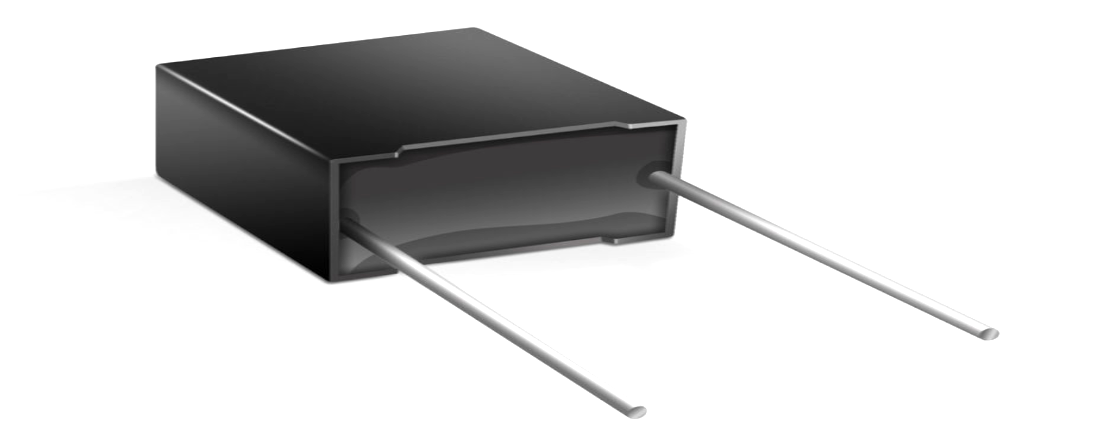
Types of plastic film capacitor dielectrics
- Posted by doEEEt Media Group
- On August 8, 2019
- 0
Film capacitors can be broadly categorized into plastic film capacitors, metallized plastic film capacitors, and composite film capacitors. The same dielectric materials are used in the construction of these different types of film capacitors. In composite film capacitors, a combination of dielectric materials is used in the construction of the component.
Film capacitors have characteristics that make them suitable for a broad spectrum of applications including filtering, decoupling, bypassing, EMI suppression, pulse coupling, blocking, and smoothing. Plastic film capacitors deliver high reliability under extreme environmental conditions. Compared to other capacitor types, plastic film devices have lower equivalent series resistance and dissipation factor.
Dielectrics used in plastic film capacitors
Plastic film capacitors offer high stability, long shelf life, low equivalent series resistance, low self-inductance, and a high ability to absorb power surges. The dielectric material used in a film capacitor greatly determines the properties of a component. Some of the key properties of a dielectric material that determine the performance of a capacitor include dielectric constant, dissipation factor, volume resistivity, maximum application temperature, dielectric strength, and dielectric absorption. These parameters vary from one dielectric material to another.
The most common dielectric materials used in the construction of plastic film capacitors are polypropylene and polyester. Other dielectrics used in the construction of film capacitors include polycarbonate, polystyrene, polytetrafluoroethylene (PTFE), polyethylene naphthalate (PEN), polyphenylene sulphide (PPS), polyimide, and paper.
Polyester
Polyester has a high dielectric constant compared to polypropylene and is one of the most widely used dielectric materials. This high dielectric constant allows the construction of capacitors with small physical sizes. Polyester capacitors, also known as mylar capacitors, have good self-healing properties and are relatively cheap.
At high temperatures, polyester capacitors dissipate more power. This characteristic makes these capacitors unsuitable for high frequency and high current AC applications. Furthermore, polyester exhibits a significant capacitance change, up to 5%, as the temperature approaches low or high-temperature limits. Due to this characteristic, polyester is an unsuitable material for constructing precision capacitors. Polyester capacitors are mostly used in general-purpose board-level applications such as blocking, bypassing, decoupling, and some noise suppression circuits.
Polypropylene
Polypropylene is commonly used in the construction of capacitors for high-frequency AC applications. This dielectric material has a low dissipation factor, high breakdown strength, low dielectric absorption, high insulation resistance, and is readily available. These properties make polypropylene a dielectric material of choice for a wide range of applications including snubber circuits, high-frequency AC systems, high voltage DC & AC systems, and high current DC applications.
Polypropylene capacitors can operate over a wide temperature range. Unlike polyester capacitors, the capacitance of a polypropylene capacitor decreases with temperature. Due to its temperature characteristics, polypropylene capacitors are commonly used to complement polyester capacitors. This is achieved by connecting a polyester capacitor and a polypropylene capacitor in parallel.
Despite its impressive properties, polypropylene has a lower dielectric constant than polyester. In addition, this material is not available in thin-gauge films. Compared to polyester, polypropylene is more expensive and is not a suitable material when the physical size of a component is a key consideration.
Polyphenylene sulphide (PPS)
Polyphenylene sulphide has excellent temperature characteristics and is commonly used for constructing precision capacitors. The capacitance of these capacitors does not vary significantly with changes in temperature. PPS capacitors are commonly used to replace polycarbonate capacitors in electronic circuits. The dielectric constants of these two materials are similar, and both have high breakdown strength.
Polytetrafluoroethylene (PTFE)
PTFE capacitors, also known as Teflon capacitors, are low loss capacitors that offer excellent stability. PTFE has a relatively low dielectric constant, around 2.1, and it is, therefore, unsuitable for constructing components with small footprints. Teflon capacitors are suitable for high-temperature applications and can be used in systems that expose components to temperatures of up to 200oC. PTFE capacitors have low capacitance values and are relatively expensive.
Polystyrene
Polystyrene capacitors exhibit extremely low loss and high capacitance stability over temperature, typically down to ±1% 0ver the range -55°C to +85°C. It’s a low dielectric constant of 2.1 makes in suitable for low capacitance, high stability applications such as timing circuits.
Polyimide (Kapton)
Polyimide has a high dielectric constant, around 3.4, and it is commonly used for constructing components for high-temperature applications. Kapton capacitors can be used in systems that can expose components to temperatures of up to 250oC. Metallized polyimide capacitors have poor self-healing characteristics.
Polycarbonate
Polycarbonate has an average dielectric constant, around 2.7, and it is commonly used in the construction of capacitors for high temperature applications. Polycarbonate capacitors are low loss components that have good electrical characteristics over a wide temperature range. Polycarbonate capacitors were widely used in military applications. However, polycarbonate film has limited availability and is not recommended for new designs.
The table below summarises some characteristics of common plastic film dielectrics.
| wdt_ID | Dielectric Material | Dielectric Constant (K) | Voltage Breakdown (V/ml) | Dissipation Factor (%) | Max. Operating Temperature (°C) |
|---|---|---|---|---|---|
| 1 | Polyester | 3.3 | 14,500 | 125 | |
| 4 | Polypropylene | 2.2 | 16,250 | 105 | |
| 7 | Polyethylene-napthalate (PEN) | 3.2 | 14,000 | 125 | |
| 10 | Polyphenylene-sulfide (PPS) | 3.0 | 14,000 | 200 | |
| 13 | Teflon™ (PTFE) | 2.1 | 7,000 | 200 |
doEEEt provides you the most complete and updated information about Hi-Rel EEE parts
Source: Capacitor Faks blog
- Space-Grade components available for immediate delivery - April 10, 2025
- Exclusive stock on doEEEt: How to access and request - April 10, 2025
- Managing EEE components for LEO and lower cost space missions - December 17, 2024



0 comments on Types of plastic film capacitor dielectrics